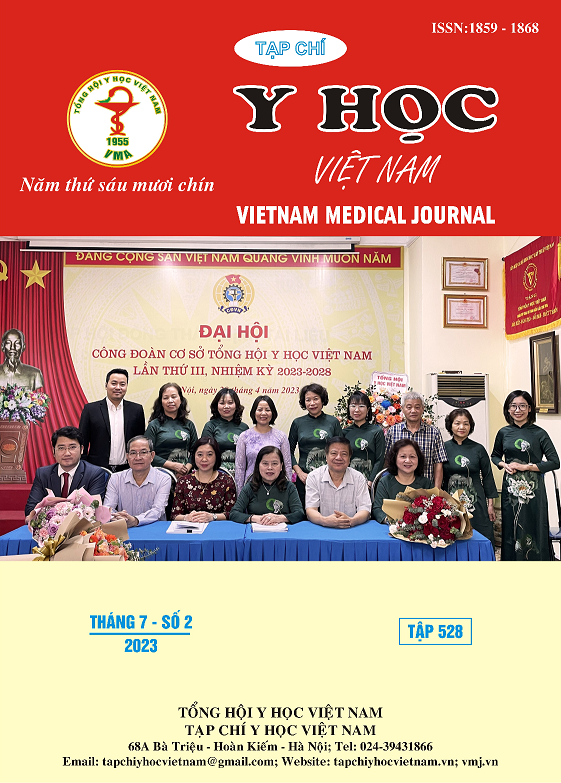SATISFACTION WITH THE WORK OF MEDICAL STAFF AT THE NATIONAL HOSPITAL OF TRADITIONAL MEDICINE AND INFLUENCING FACTORS IN 2023
Main Article Content
Abstract
Objective: Describe the job satisfaction of medical staff at the National Traditional Medicine Hospital in 2023. Research methodology: Research with analysis, combining quantitative with qualitative, sequence. The quantitative study using a set of survey questionnaires issued by the Ministry of Health in 2015 together with Official Letter No. 1334/KCB-QLCL of the Medical Examination and Treatment Administration had a total of 471 health workers selected to participate in the study. Qualitative research purposefully selects subjects to conduct in-depth interviews on a number of factors affecting the job satisfaction of health workers. Use SPSS 20.0 software to describe GPA, standard deviation, use testing when squared to find out relevant factors. Results: The satisfaction rate of each subsection was over 90%, of which the highest was the subsection on facilitating medical staff to improve their professional qualifications with 95.3% and the lowest was satisfaction with the assigned workload. The overall job satisfaction, learning opportunities and advancement of healthcare workers was 91.5%. However, comments also said that the shortage of medicines and supplies used for patients makes it difficult for health workers. Partly psychological effects, causing psychological depression and stress when having to explain to patients. This negatively affects the satisfaction of healthcare workers. Conclusion: Hospital leaders need to take appropriate interventions such as: Supplementing policies, rewards and incentives for medical staff working during holidays and Tet. In addition, it is necessary to have a mechanism to attract and retain qualified human resources, groups of health workers under 35 years old, with difficult family circumstances.
Article Details
Keywords
Job satisfaction; Satisfied; Business; Healthcare workers; Central Hospital of Traditional Medicine.
References
2. Paul Spector. Job Satisfaction: Application, Assessment, Causes, and Consequences. Thousand Oaks, California1997. Available from: https://sk.sagepub.com/books/job-satisfaction.
3. Bệnh viện Y học cổ truyền trung ương. Báo cáo kết quả hoạt động năm 2021 và Phương hướng hoạt động năm 2022. 2021.
4. Getnet Gedif, Yetnayet Sisay, Animut Alebel, Yihalem Abebe Belay. Level of job satisfaction and associated factors among health care professionals working at University of Gondar Referral Hospital, Northwest Ethiopia: a cross-sectional study. BMC Res Notes. 2018;11(1):824-.
5. E. T. Bekru, A. Cherie, A. A. Anjulo. Job satisfaction and determinant factors among midwives working at health facilities in Addis Ababa city, Ethiopia. PloS one. 2017; 12(2): e0172397.
6. SSM Rashid. Determinants of job satisfaction among nurses at the Muhimbili National Hospital 20132013.
7. Nguyễn Văn Liêm, Đỗ Mai Hoa. Sự hài lòng đối với công việc của nhân viên y tế và một số yếu tố ảnh hưởng tại bệnh viện Đa khoa Khu vực huyện Tiểu Cần, tỉnh Trà Vinh năm 2020. Tạp chí Khoa học Nghiên cứu Sức khỏe và Phát triển. 2022;6(01):133-40.
8. Lê Trí Khải, và cộng sự. Sự hài lòng đối với công việc của nhân viên y tế cơ sở tỉnh Kon Tum năm 2016. Tạp chí Y học dự phòng. 2016;27(8):374-84.
9. Huixuan Zhou, Xueyan Han, Juan Zhang, Jing Sun, Linlin Hu, Guangyu Hu, et al. Job Satisfaction and Associated Factors among Medical Staff in Tertiary Public Hospitals: Results from a National Cross-Sectional Survey in China. Int J Environ Res Public Health. 2018;15(7):1528.
10. Vũ Xuân Phú. Thực trạng nguồn nhân lực và một số yếu tố ảnh hưởng đến sự hài lòng với công việc của nhân viên y tế Bệnh viện đa khoa Sóc Sơn, Hà Nội năm 2011. Tạp chí Y học thực hành. 2012;821:153-1589.


